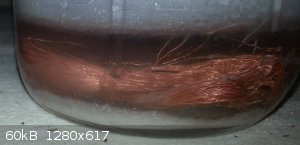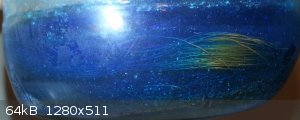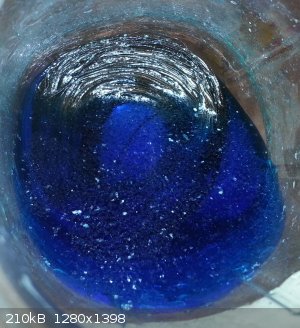RogueRose
International Hazard
    
Posts: 1595
Registered: 16-6-2014
Member Is Offline
|
|
Cu reactions with NaOH, NH4OH & (NH4)2SO4
I was told that NaOH would oxidize Cu to give an oxide. This seemed to happen when I used molten NaOH but a 50/50 w/w of Lye/H2O seems to do nothing
as far as oxidation and actually keeps any oxidation from forming on the copper (keeps its very shiny surface).
All pictures are the result of about 3 weeks of uncovered soaking in the solution which has resulted in evaporation of water and ammonium.
I am most confused as to the reaction of the few drops of H2O2 to the NaOH solution (Pic 2)
Here is a picture of 100ml/100g H2O/Lye + 40g Cu wire.

Here is a picture of 200ml/200g H2O/Lye + 40g Cu wire. I did add a couple drops of 3% H2O2 and it immediately gelled somewhat and started to turn the
solution blueish.

Here is a solution of 50g Ammoium Sulfate / 100g H2O & 40g Cu wire

These 2 are "ultra concentrated" Ammonia cleaning solution. It is supposed to be pure and I believe it is. I would guess it is below 10% Ammonium
Hydroxide by weight to water. IN the last 4-7 days small flakes have started to appear in the solution. They seem to be copper but I am unsure how
these flakes would have appeared. The container has been left uncovered for just under 3 weeks.


|
|
|
morsagh
Hazard to Others
  
Posts: 187
Registered: 20-2-2014
Member Is Offline
Mood: No Mood
|
|
Just NaOH can´t oxidize Cu, there must be some oxygen or something to make galvanic cell. H2O2 can be used as oxidizer instead of O2 so this caused
oxidation of copper wire in pic. 2. Your product is most probably Na2[Cu(OH)4].
|
|
|
solitanze
Harmless

Posts: 26
Registered: 4-2-2016
Member Is Offline
Mood: No Mood
|
|
Indeed, what you have is a solution with cuprate ions. The higher the concentration of hydroxide, the bluer the color of the solution.
Such solutions are easily prepared, but isolating the pure substance isn't easy at all.
|
|
|
MrHomeScientist
International Hazard
    
Posts: 1806
Registered: 24-10-2010
Location: Flerovium
Member Is Offline
Mood: No Mood
|
|
I would think that leaving a container of ammonia (not ammonium!) out for that long, all the ammonia would escape.
You get the nice deep blue color in those beakers because of the ammonia complex with copper ions - it's very dark blue, so a tiny amount of dissolved
copper will cause a strong color. None of those things should cause an appreciable reaction with copper, though. You need an oxidizer. In this case it
was the hydrogen peroxide you added to one and atmospheric oxygen in the others, like those above have said.
|
|
|
eanardi
Harmless

Posts: 10
Registered: 20-11-2015
Location: Inside a buckyball -BR-
Member Is Offline
Mood: No Mood
|
|
Once I did the reaction between NH4OH and Cu, after adding a few drops of 3% H2O2 the reaction ocurred spontaneously and all the copper dissolved.
This stayed in my reagents shelf for some months, when i got it again there was a layer of ammonia and a layer of some orange (not what the copper
Orange would look like) compound that i dont know what is, does anyone know what it could be? (After shaking the system everything mixed again and
became a blue solution again)
|
|
|
AJKOER
Radically Dubious
    
Posts: 3026
Registered: 7-5-2011
Member Is Offline
Mood: No Mood
|
|
Here is one possible answer per Atomistry.com which is an historical extract from the literature, to quote:
"Cuprous oxide is produced in the form of an orange-yellow, amorphous gel containing water by the reduction of an alkaline cupric solution with sodium
hyposulphite:
2CuO + Na2S2O4 + 2NaOH = Cu2O + 2Na2SO3 + H2O.
A better method is the action of hydroxylamine on a cupric salt in presence of alkali. The initial light-yellow product is probably a hydroxide. In
absence of air, the colour quickly changes to orange or brick-red, the phenomenon being probably due to elimination of water. The dry product contains
2 to 3 per cent, of water, but above low red heat this water is expelled, the metastable, yellow, amorphous oxide becoming transformed into the
stable, red, crystalline variety. "
Link: http://copper.atomistry.com/cuprous_oxide.html
I suspect with time leaving Cu in the cupric solution produced the Cu2O. It is also possible, per my recollection, that the action of hydroxyl
radicals on NH3 forms .NH2 which can further form NH2OH. The hydroxyl radicals could have been created from the action of light on H2O2, or a
Fenton-type reaction involving cuprous and HNO2 (a known side product includes NH4NO2, see https://www.sciencemadness.org/whisper/viewthread.php?tid=64... ).
Here are the possible radical paths to NH2OH:
NH3 + OH· → H2O + ·NH2
·NH2 + OH· → NH2OH
See reactions [98] and [96] in reference, "On the aqueous reactions of the aminyl radical with molecular oxygen and the superoxide anion" at https://www.google.com/url?sa=t&source=web&rct=j&... and the presence of nitrite is a photocatalytic source of hydroxyl radicals, see
https://books.google.com/books?id=RAJMmvbfyzgC&pg=PA383&... ).
[Edited on 21-5-2016 by AJKOER]
|
|
|